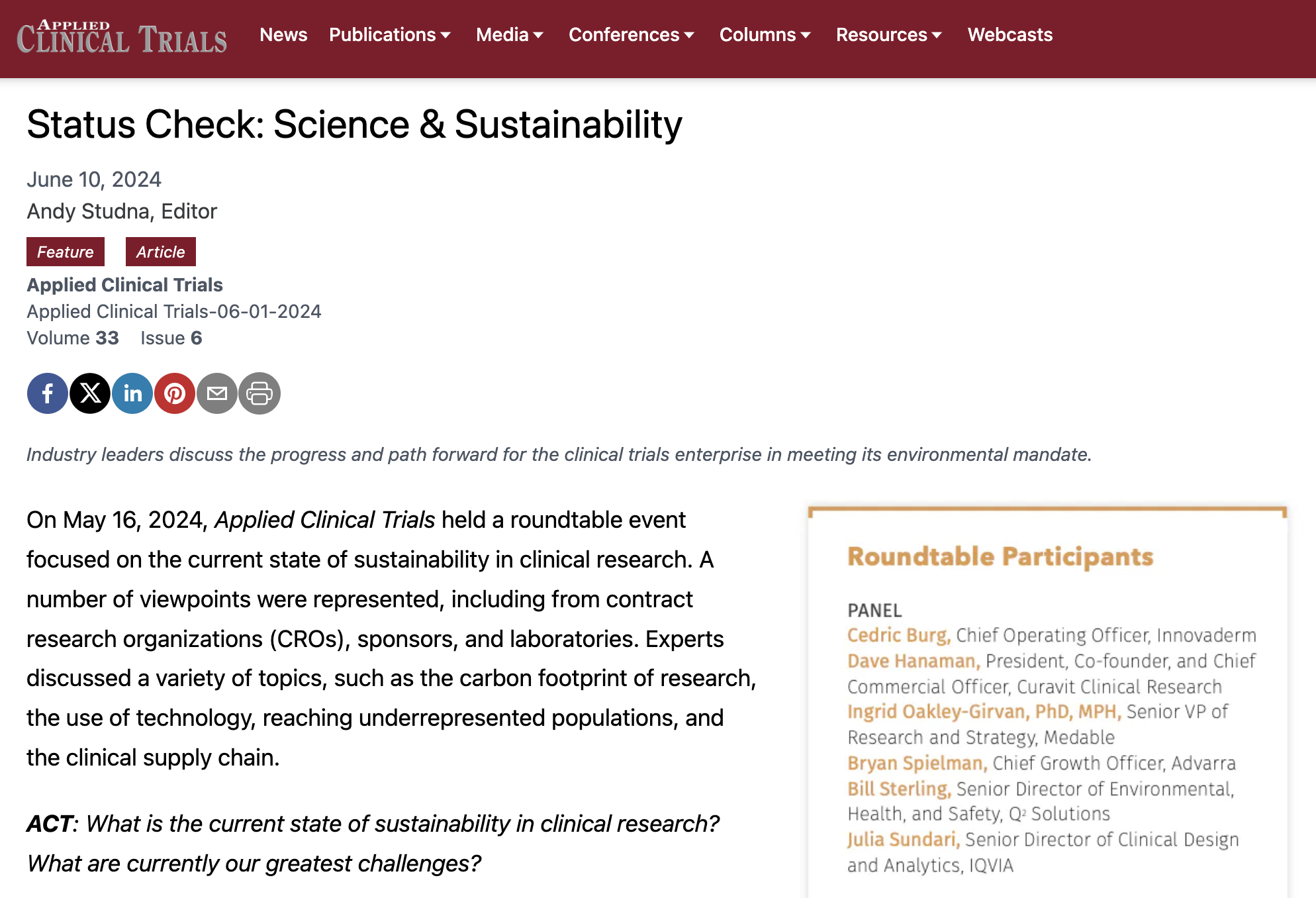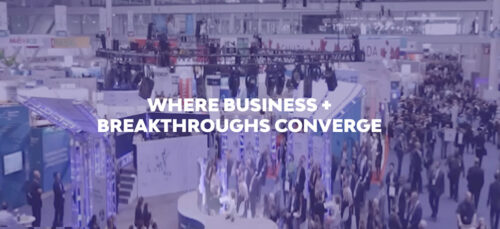June 10, 2024

On May 16, 2024, Applied Clinical Trials held a roundtable event focused on the current state of sustainability in clinical research. A number of viewpoints were represented, including from contract research organizations (CROs), sponsors, and laboratories. Experts discussed a variety of topics, such as the carbon footprint of research, the use of technology, reaching underrepresented populations, and the clinical supply chain.
ACT: What is the current state of sustainability in clinical research? What are currently our greatest challenges?
Bill Sterling, Senior Director of Environmental, Health and Safety, Q2 Solutions:

Bill Sterling
I think there’s growing enthusiasm. There’s certainly a lot of enthusiasm at Q2 for sustainability initiatives. There’s a sense of pride as employees start to see that this is a high priority and an uptake at the highest levels. That’s been exciting to see. I think things are really growing and expanding in this area. In general, laboratories can be particularly challenging in terms of finding ways to improve sustainability given labs require energy-intensive equipment like ultra-low temperature freezers and single-use plastics for safe sample collections.


Ingrid Oakley-Girvan, PhD
Ingrid Oakley-Girvan, PhD, MPH, Senior VP of Research and Strategy, Medable: I’m really pleased by the number of our customers that are reaching out to ask us, “Do we have a sustainability plan? Have we started this process?” It’s really heartening to see that there is concern about that and assessing where the gaps are and areas with the greatest potential impact. If you’re just expending a little bit of energy in one place and you put all your eggs in that basket to try to solve that problem—water, or greenhouse gases, etc…from the sustainability metrics—then you can’t get that far. But if you know where there’s a big chunk, that’s the piece that you can focus on, and I think that’s part of why they’re asking us.

Cedric Burg
Cedric Burg, Chief Operating Officer, Innovaderm: I would agree. I would add, I think we’re not one of the big polluters, right? We’re not the mining industry or the oil and gas industry; but what our biggest impact is, apart from the facilities that you both were mentioning as well, I think is the travel. We do a lot of travel to run clinical trials. We organize those large investigative meetings, people flying in from all over the country or all over the world. And of course we’ve got CRAs (clinical research associates) going to sites quite a bit, and, not to forget, we’ve got patients going to sites as well.
I think our biggest challenge is that because we can do a lot of things, we’re still going to need to do quite a bit of travel, and the more trials we’ll do, the more travel. Unless we see a complete decarbonization of travel, we will still have that impact and have to find other ways to mitigate it.

Bryan Spielman
Bryan Spielman, Chief Growth Officer, Advarra: It’s hard as a software company when you respond to surveys from pharma companies—we are not a manufacturer, we are not a lab, we don’t do that sort of stuff. But what we do have is a great deal of data that helps you determine what is the optimal site to perform a clinical trial, who are your best patients, what capabilities do those sites have, so that instead of going to 10 different places to hit all the different experiments that [patients] need to have done, [you discover] the one site that has all of them—so let’s direct trial activity to those places. I think using data, using analytics to help improve the operational efficiency of a trial is much better than putting my laptop on low power mode. It’s going to have a lot more of an impact, frankly. And those are some of the ways that we’re thinking about it.
ACT: With the complexity of rare diseases trials, sustainable practices might be less of a priority. Should companies face up to their environmental impact at the risk of thousands of rare disease patients potentially missing out on a therapy? What’s the trade-off? Is there a way to balance the two?

Dave Hanaman
Dave Hanaman, President, Co-founder, and Chief Commercial Officer, Curavit Clinical Research: The direct answer in my view is no. The research, by definition, is the priority. Priority means “first”—there’s only one first we’re about: research. We can affect research. We are not going to invent the technologies that are going to save the planet. Now, that said, we can be efficient, we can be effective, we can choose sites that are efficient, and do a good job. Those are the things we can do. There is only one priority and that’s the research—and that’s for the patients.
We can and should do these other things, but not in any way, shape, or form that impacts the ultimate research.
Oakley-Girvan: I think there’s also this assumption that if a patient with a rare disease enrolls in a clinical trial, somehow that has a greater carbon footprint than what they would do otherwise if the trial wasn’t available. I’m not sure that actually is an accurate assumption because [patients] could be traveling hither and thither looking for a cure. They could actually have a greater travel carbon footprint, for example, than if they just go to a specific trial site that might be in the same country versus multiple countries away.
Sterling: Yes, there is a way to balance the two in terms of trade-offs. I think there’s impact in terms of human quality of life and longevity with regards to rare disease, but there’s also an impact to using dirty energy to achieve it. The emissions of greenhouse gas and other pollutants into the air have an enormous impact on human health. So it’s absolutely both. First and foremost, the reason to advance these ambitions is it’s the right thing to do. We all know that—we’re all here because we care about the environment.
There are certainly increasing regulations, and meeting those regulations is something that needs to be done. But, also, there are often cost savings that can be uncovered; often, it supports business growth. Our shareholders and our clients are pushing this program as well. It’s about aligning to a competitive market and, in addition, attracting and retaining good talent. I mentioned that a number of our employees get really excited when they’re involved in the laboratory green teams or when they see leadership championing sustainability ambition. So it has to be both.

Julia Sundari
Julia Sundari, Senior Director of Clinical Design and Analytics, IQVIA: I don’t think it always has to be a disadvantage to our businesses when we focus on sustainability. Because if you can be out on the forefront of this, then your sponsors are going to want to turn toward you if your carbon footprint is lower and if you can offer a clinical trial with a smaller carbon footprint and you have solutions to some of these things. [After all,] they’re looking to do that themselves.
So, from the sponsor down—everybody as a human being on the planet earth—we all really serve the end game of accomplishing this together, whether it’s at work or whether it’s personally in our lives.
ACT: One of the longest-standing challenges in clinical trials over the years has been patient participation, especially within underrepresented populations. How can we address this to make trials more sustainable?
Hanaman: Greater diversity and better efficiencies are important pieces in our experience. [But] the dominant opportunity here is in speed. The faster we do something, the less energy we’re using in conducting it. And then, secondly, the adherence. The more patients we can keep in a trial, the better the adherence, the better the data, potentially, the shorter the trial, etc.
Sundari: We want to make sure that we don’t forget the carbon impact. So while, absolutely, DCTs (decentralized clinical trials) can impact carbon from a positive effect, at times it’s neutral. If we’re just replacing an on-site visit with a home health nurse physically still traveling to the patient, then it may net the same amount of carbon being used. I think it’s certainly about the design, it’s about looking at how many of these things can we make virtual, how much of the data can actually be wearable, or other ways where it’s electronic data capture directly from the patient. And then, of course, the more we centralize, the more carbon neutral we become, because we hopefully don’t need to physically go to places to see that data and monitor that data.
Spielman: I think along those lines, injecting technology into sites that have been less research-intensive is also important.
We are partnered with Novartis on its Beacon of Hope initiative, which is about creating centers of excellence at historical black colleges and university medical centers. Why is that good for sustainability? One, we talked about the idea of sustainability—about bringing underserved populations into the process. Two, it’s actually bringing the clinical trial closer to those underserved populations that live in those communities where those medical centers are educating doctors to be able to serve those communities. And I think it’s creating the “clinical research as a care option,” which is also a sustainability benefit.
ACT: Technology use is increasing rapidly in clinical trials, especially with the boom of AI and wealth of available data. How is it being used to make trials more sustainable?
Sundari: The way I see AI directly impacting the clinical trial space is around leveraging that information on our data. So targeting analytics and machine learning so that we can mine that incoming data remotely—physically have boots on the ground at the site but internally consuming that data and understanding where the risks are and correcting them more quickly, even in the middle of a trial. And being more environmentally sensitive to where we actually do need to send those monitors to the site.
Spielman: I would say AI/machine learning has so many different applications across each of the areas, and anytime you’re driving efficiency, you’re probably doing something that’s more sustainable. With protocol design, for example, it’s making sure you get it right the first time so you can minimize the number of amendments and modifications that need to be made in the trial to the extent it’s feasible. There’s also quality monitoring, there’s the ability to ingest large amounts of data and determine which sites are our potentially problem sites, and then you deploy your CRAs to those sites as opposed to every single site, which is pretty inefficient.
There’s all sorts of applications, but I think the easiest one is trying to reduce the amount of bodies that you have to send out to various locations.
Burg: I want to raise the other side of the issue. I think there’s also a big risk to using AI in our work, which can create a lot of work that is not necessarily needed. When I started, we had monitoring plans that were half-a-page or a page-long. Now we have 50 page-long, 80-page long monitoring plans. Because we can probably easily do it with AI, I’m afraid we’re going to turn out 180-page or 200-page documents, perfectly written and very well organized without all those typos, but that are really not going to help the monitor. That’s my worry. We also have to be careful about all the new technology because sometimes there’s a lot of hype around it.
ACT: What are some roadblocks we are currently facing in the clinical supply chain? How can they be addressed?
Sterling: It’s really a challenge in terms of conserving energy in a laboratory. You’ve got a very large need for energy with regards to HVAC systems, fume hoods, clean air, single-use plastics, and so forth. One of the things that has been extremely helpful for us is partnering with a group called My Green Lab. It’s a nonprofit organization that essentially provides a scored self-assessment survey training across 14 different topics that map onto laboratories. Topics like cold storage, green chemistry, fume hood use, and plug load for equipment.
Starting in 2022, we launched into the My Green Lab certification process to assess our baseline practices. It created a lot of enthusiasm, a roadmap, and a structure for people to latch onto to learn about and engage various sustainability programs and projects. The most important thing is we’ve delivered some real carbon reductions and provided value for our clients. It means something to them for us to be able to say, “These sites are platinum, these sites are green-certified as the highest you can get—gold and bronze and so forth.” It gives sites a tangible roadmap and ambition to move upwards on the podium.
Oakley-Girvan: That sounds like a great program. I know we’ve been working with some of our customers that want us to do what’s called a RAG, a red-amber-green assessment, every 60 days. This includes science-based target initiatives. If we’re sending out sensors, we’re thinking about the packaging, all the energy that goes into making those, how can our sensor vendors be more efficient? That’s a big space.
Hanaman: In terms of sustainability goals, I find it almost funny the paradox, in my experience, of DCTs and remote data capture. The paradox is that there’s a lot of “stuff” now that you’ve got to get out to the patients. It used to be all the “stuff” was at the sites and the patients just had to get there. I think this logistics question is a really important one because the more we take advantage of these digital processes and technologies, the more we as CROs, sponsors, and companies take on the challenge of getting this stuff out to the participants in the trial.
There’s a couple of different ways to think about that. One is simply that policy and regulation can drive this a little bit. The other is thinking about medical grade products and the cost and the energy that it takes to build them. What is it we’re trying to collect from that patient? Do we need to spend ‘X’ and do it using an Apple Watch or do we have to spend ‘10X’ for some medical grade component that has a much heavier energy footprint and is thrown out after the trial?
There are so many products out there that don’t have to be reinvented for clinical trials, don’t have to be reinvented for care—but can simply be repurposed through algorithms. So just creatively thinking about simple ways to get simple products out into people’s hands.
ACT: What does having more sustainability in clinical trials look like from your perspective in five years? What do you hope the industry can accomplish by then?
Sundari: I feel like we’re on sort of a wave where more and more companies are getting to the point where they’re willing to commit to their goals—their science-based target goals—and having those approved. I would say that would be the first step for wherever you sit in the business—to make sure that your company, your corporation, your part of this industry is focused on it.
I think for clinical trials at large, we touched on many of the things that I would say are probably the handholds or footholds. It’s digitizing for sure. It’s making sure that we’re using technology to our best as far as the end-to-end supply chain; making sure that we’re designing protocols as intelligently as possible; and that we aren’t incurring additional manufacturing, shipping, and travel wherever possible. However, how we can do those things most intelligently across the board is really the goal.
Sterling: And to build on that, Julia, you mentioned SBTI—the science-based target initiatives. I think transition to renewables at a number of our sites is important, either through purchase agreements or installations and packaging in kits that go out to patients. Reworking those so that they’re sustainable. I also spend a lot of time thinking about culture because I’m in environmental health and safety and sustainability; both of those things really depend on employees being energized and engaged and having a sense of ownership.
I see that happening already, but in five years, my hope is that it’s even stronger and it’s something that we see around the world. I think we have an opportunity as the younger population is coming into our workforce to take advantage of the fact that they really care about this.
Hanaman: We’ve talked about a lot of technologies today, such as AI, that are creeping in upstream from us and already being adopted. So I think at a very simple level, those things will be flowing through to us and will be more sustainable as a result.
But I’m going to pick up on Bill, who mentioned the word culture. To me, the big driver here is that in five years, I actually think our industry is going to look a lot different, and I think it’s going to be because of, not the intersection, but maybe the collision of tech and health. We’re a small segment of the healthcare industry. I think the industry is going to be radically disrupted in the next three to five years by these technologies, but more importantly, by the culture and by the people that we’re going to have around us and part of us in designing these things.
I think it comes down to folks like us on this call designing these trials from first principles—not designing them the way we’ve always done and then shoehorning technology into them, but designing them from first principles with a knowledge of what actually can be done.
I think that in the next three to five years, we’ll see a massive shift in that mentality.
Spielman: I think more excitement around this as a sustainable industry is actually a good marketing position to have. Again, you want to attract younger people to clinical research, and they are attracted to sites that are greener and attracted to what’s viewed as a more sustainable process. I think that will help.










